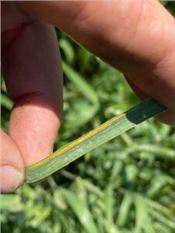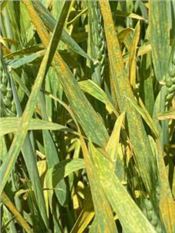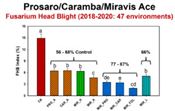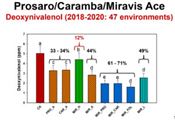Wheat Disease Update And Fungicide Considerations
DR. HEATHER MARIE KELLY
JACKSON, TENN.
As wheat approaches bloom, start considering fungicide options. While up until today little to no disease had been reported in Tennessee this season, stripe rust has just been sighted in West TN. So scouting should be continued and the Fusarium Head Blight (Scab) Prediction model should be consulted when considering fungicide applications.
Up until today there had only been reports of leaf blotches in the lower to mid-canopy. Today the first report of stripe rust of the season came in (Haywood County), with very low severity and incidence (image 1) to larger areas with high severity (image 2). With temperatures still in the optimal range and forecasted rain events, stripe rust could develop quickly and rob yield. Depending on the amount and severity of stripe rust in a field, variety susceptibility, and growth stage an immediate fungicide application may be recommended. Fungicide product efficacy for stripe rust can be found on the fungicide efficacy table found at https://extension.tennessee.edu/publications/Documents/W341.pdf
. Be mindful about picking fungicide products that can protect yield from multiple diseases and be sure to clearly identify what diseases you are seeing in wheat by using the mobile friendly field guide at guide.utcrops.com and additional disease information can be found on the UT Extension Publication – Fungal Wheat Disease Identification https://extension.tennessee.edu/publications/Documents/W662.pdf . Foliar diseases close to or on the flag leaf would can justify a fungicide application. Again, consult the fungicide efficacy table found at https://extension.tennessee.edu/publications/Documents/W341.pdf to make sure the product is matching the disease you’re trying to manage.
If risk increases for Fusarium Head Blight/Head Scab in your area a fungicide application can be warranted to protect yield and reduce potential levels of vomitoxin/DON. Check the Fusarium Head Blight (Scab) Prediction model found at http://www.wheatscab.psu.edu/ to see your risk, don’t forget to use the menu in the upper left corner to change variety susceptibility as needed.
Particular fungicides to manage Fusarium Head Blight(FHB)/Head Scab are Caramba, Proline, Prosaro, and Miravis Ace. Fungicide products that contain a strobilurin (FRAC or fungicide group 11) can increase the mycotoxin levels in FHB infected wheat and hence, should be avoided at heading and later timings. Figures 1 and 2 show data from regional trials looking at the different Head Scab products: Prosaro (PRO), Caramba (CAR), Miravis Ace (MIR), Folicur (FOL) and different timings: anthesis/bloom (A), 50 percent heading (H), or 4-6 days after anthesis (L). Take home messages from these data:
• Both pre- and post-anthesis treatments were effective at reducing FHB • Miravis Ace was just as effective against FHB and DON as Caramba or Prosaro when applied at anthesis • Efficacy of Miravis Ace was comparable between anthesis and late applications but less consistent for early heading application • Two-treatments programs – an anthesis application of Miravis Ace followed by an application of Caramba, Prosaro, or Folicur 4-6 days later – led to the greatest reduction in DON • Sequential application of Miravis and a DMI to a moderately resistant cultivar resulted in the highest levels of FHB and DON control Special thanks to Dr. Pierce Paul for compiling regional data and graphs from the U.S. Wheat and Barley Scab Initiative (https://www.scabusa.org/ ).
FHB/Head Scab infection is favored by extended periods of moisture (3 or more days with frequent rainfall) or relative humidity (>90 percent) and moderately warm temperatures (between 59 to 86°F). These conditions present before, during, and after bloom favor spore production, flower infection, and colonization of developing grains.
While wheat is susceptible to infection from head emergence until harvest, infections initiated at and soon after bloom have the greatest destructive potential. Research has shown the most effective timing for controlling FHB and mycotoxin levels is at initial bloom/ flowering (Feekes 10.5.1), which relates to at least 50 percent of the heads blooming in a field. Although applications made 5 to 6 days after initial bloom can also provide a benefit in reducing FHB and mycotoxin levels.
Final note on Head Scab management, while fungicides can reduce disease and mycotoxin levels in wheat, the pairing of fungicide with a tolerant Head Scab variety will provide the best protection. More information, including variety susceptibility/tolerance to Head Scab can be found at scabsmart.org. ∆
DR. HEATHER MARIE KELLY: Extension Plant Pathologist, University of Tennessee

Image 1. Low severity of stripe rust

Image 2. High severity of stripe rust

